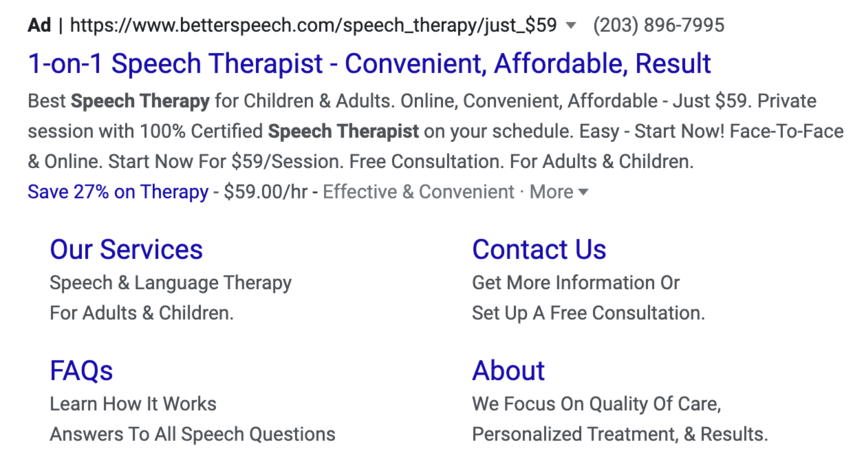PPC for Speech Therapists: 6 Effective Optimization Tips
Learn how to maximize your speech therapy PPC campaigns with WebFX. Target branded keywords, list negative keywords, craft custom audiences, use RLSA, create display ads, and use ad extensions.
-
insights from 98,500+ hours of health & wellness marketing experience
Go to Google and search for a term like “speech therapy services.” In addition to the standard list of organic rankings, chances are you’ll see a few results at the top of the page that say “Ad” in the top corner.
Paid search ads appear even higher than organic results, meaning they’re often the first things users see on the page. That makes pay-per-click (PPC) advertising a highly effective means of marketing to people through Google.
But what is PPC for speech therapists, and how can you use it to drive results for your own marketing campaigns? We’ll answer both of those questions below, so read on to learn more about speech-language pathologist (SLP) PPC.
Then consider partnering with WebFX — the agency with over 28 years of online marketing experience — for our expert PPC services. Just call us at 888-601-5359 or contact us online today to get started!
What is PPC for speech therapists?
Speech therapy PPC is a form of paid advertising that involves displaying ads at the top of Google search results or in the margins of third-party websites. The best platform for setting up your speech therapist PPC campaigns is Google Ads.

In Google Ads, you can list specific keywords — that is, search terms — that you want to target with your ads. Some example keywords you could target are “speech therapy in [your city]” or “child speech therapy services.”
Once you know which keywords you want to target, you can bid on them in Google Ads. Then, whenever someone searches for one of those terms, Google may display your ads based on your:
- Bid amount
- Quality Score (Google’s assessment of your ads’ quality)
With an optimal bidding strategy and a high enough Quality Score, you can get your ads to appear at the top of search results. Best of all, you only pay for your ads when people click on them, making SLP PPC a highly effective strategy when done well!
Our digital marketing campaigns impact the metrics that improve your bottom line.
See More Results
WebFX has driven the following results for clients:
$6 billion
In client revenue
24 million
Leads for our clients
7.14 million
Client phone calls
6 expert speech therapist PPC tips
Looking for some guidance to help you achieve the best results through your speech therapist PPC campaigns? Look no further. Below, we’ve laid out some tips to help you optimize your paid ads.
Here are six ways to give your speech therapy PPC a boost!
1. Target branded keywords
Targeting relevant keywords is essential to a successful PPC campaign, and few types of keywords will prove more effective than branded keywords. Branded keywords are directly associated with a particular brand, with one example being a company name.
When you target your practice’s branded keywords, you can drive more reliable conversions because anyone looking up your branded keywords already has a clear interest in you. That means they’re more likely to respond positively to your ads.
2. List negative keywords
While the keywords you bid on tell Google which searches to display your ads for, you should also seek out another type of keyword — negative keywords. You don’t bid on negative keywords, but you can list them in Google Ads as terms you want your ads to avoid.
For example, let’s say you target the keyword “speech therapy services,” and Google displays your ads for different variations on that keyword. One such variation could be “adult speech therapy services,” while you may only offer services for children.
In that case, your ad wouldn’t be useful in the search for adult services, so you could benefit from adding “adult” as a negative keyword. That would prevent you from wasting ad spend on an irrelevant audience.
3. Create custom audiences
Another way to hone your ads’ focus is to create custom audiences in Google Ads. Custom audiences are essentially a way for you to direct your ads to highly specific groups of people based on particular sets of traits.
Some features you can target include:
- Age
- Gender
- Occupation
- Location
- And more!
For example, maybe most of the people you want to target are women between 30 and 50 in Chicago. You could create a custom audience using those features, which would tell Google to direct your chosen ads exclusively to people who fit that description.
By using custom audiences, you can reach a more relevant audience and ultimately drive more conversions.
4. Harness the power of RLSA
While SLP PPC ads can be excellent tools for spreading brand awareness to people who’ve never heard of you, they’re also effective for marketing to people who have already interacted with you in the past — specifically, people who have visited your website.
With remarketing lists for search ads (RLSA), you can have Google track traffic to specific pages on your website. Whenever someone visits one of those pages, Google will know to start directing your ads to them later on.
Since they’ve already visited your site and thereby expressed interest in you, they’ll be some of the most likely people to respond positively to your ads, allowing you to drive far more conversions.
5. Craft display ads
Not all your PPC ads need to appear in search results. Google Ads will also let you create display ads, which can appear in the margins of qualifying third-party websites.
The advantage of crafting display ads is that they allow you to reach users you might miss in the search results. Maybe you deduce that many of your potential patients read a particular news site, so you want to display your ads there.
Additionally, display ads allow you to use images in addition to text, helping make your ads more eye-catching and compelling. That can lead to them generating more clicks than search ads and possibly improving your overall conversion rate.
6. Use ad extensions
Another useful Google Ads feature you should consider taking advantage of is ad extensions. When you use ad extensions, you can display more information within your search ads.

Normally, search ads consist of a link, a title, and a description. With ad extensions, though, you can add additional pieces of information below your description. That information can include:
- Location
- Phone number
- Site links
- And more!
The benefit of ad extensions is that they might draw in people who aren’t attracted to your title or description alone. Someone might scroll past the standard version of your ad, but stop and click if they see a version with a particular site link listed below it.
Traffic attracted through PPC advertising yields 50% more conversions than organic advertising.
Are you leveraging PPC in your marketing efforts? Let’s get started.
View the Guide

WebFX has what it takes to optimize your speech therapy PPC
Want to take your SLP PPC to its full potential and give your conversions a boost? WebFX can help you do that! With over 1,100 client testimonials, we’re the agency small businesses trust to drive superior results for their online marketing.
With our PPC services, you’ll get help optimizing your campaigns for each of the tips listed above and more. You’ll also receive a dedicated account representative to keep you informed of everything we do for you.
To get started with us, just give us a call at 888-601-5359 or contact us online today!
We Drive Results for Speech Therapists
- 230+ health industry experts
- Renowned for our communication and transparency



We Drive Results for Speech Therapists
- 230+ health industry experts
- Renowned for our communication and transparency



Explore our health & wellness case studies
Read our case studies for a more in-depth look at our results.
Solving key challenges for speech therapists
Our website isn’t driving enough traffic
Our expert SEO specialists, copywriters, and digital advertisers will help you increase your website’s rankings when your target audience searches for your treatments online, so you can continuously drive traffic and revenue for your practice, hospital, or business.

We’re opening a new location
Set your new hospital, brand, or practice up for future success with a range of digital marketing strategies that get your new practice in front of potential patients or B2B buyers.

We’re not attracting enough patients
Get a steady flow of new patients to your practice, hospital, or brand with expertly crafted strategies that provide a seamless, engaging user experience for your website visitors, encouraging them to become patients.

We have high patient turnover
Offer new treatments or services and need to get them in front of your potential client’s eyes? Our range of revenue-driving digital advertising and marketing services have you covered and reach the people who need your facility the most.


